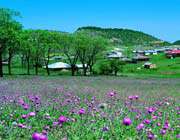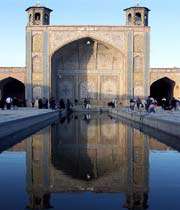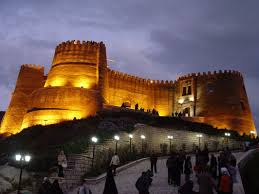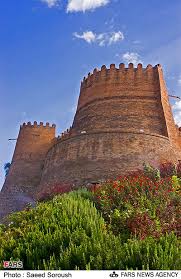
دنیای زبان انگلیسی ( بهروزپور )
لغات و اصطلاح .داستان کوتاه . شعر.جوک .ضرب المثل.اشپزی.رمان. نمایشنامه.متن دوزبانه
دنیای زبان انگلیسی ( بهروزپور )
لغات و اصطلاح .داستان کوتاه . شعر.جوک .ضرب المثل.اشپزی.رمان. نمایشنامه.متن دوزبانهروستای جهان نما
Jahan - nama village

Not all villages in different parts of Iran are permanently residential. Some of them play the role summerhouses for residents of near cities, and therefore are left during autumn and winter. Jahan-nama village is one such village. This village is 60 km south east of the city of Kordkuy, 85 km away from Gorgan, and is on the skirts of a mountain with the same name. Jahan-nama Mountain has its peak with the altitude of 3086 meters above sea level. Jahan-nama village enjoys moderate summers but cold winters. The low temperature and snowing during fall and winter make the people leave the village. However, as mentioned before, people of Gorgan and Kordkuy summer in this village during the two seasons of spring and summer. Therefore, during these two seasons, Jahan-nama not only hosts native villagers but many tourists and guests as well.
ادامه مطلب ...
Shiraz
Old Mosques, Fars
Atiq Jame Mosque, Shiraz
This mosque was built in celebration of the conquest of Shiraz by Saffarid Amroleiss in the year 276 A.H. and was completed in 281 A.H. It has been restored many times. The height of the building and its various nocturnal areas (Shabestans) with beautiful tile work on the ceilings, gives a unique charm to this place.
Nasirol Molk Mosque, Shiraz
This mosque is situated at the end of the Lotfali Khan-e-Zand Street. Nasirol Molk, who was one of the elites of Shiraz, is the founder of this mosque. This mosque is unique for its tile work and architecture. The construction work of mosque began in 1293 A.H. and was finally terminated in 1305 A.H., by Muhammad Hassan Me'mar and Muhammad Reza Kashi Paz Shirazi.
Noe (Shohada) Mosque, Shiraz
In the old times it was called the Atabak Mosque. Its construction work began in 598 A.H. by Atabak Sa'd-ebne-Zangi and was completed in 615 A.H. This very large mosque has a ceiling that is 40 m. high and 25 m. wide supported by 12 lower sections. Its building has been recently restored.
Vakil Mosque, Shiraz
It is one of the most valuable monuments dating back to Zandieh period. Its construction was completed in 1773 A.D. The said premise with an area of 3600 Sq.m. has been furnished with large stones. Its nocturnal area or Shabestan (night prayer hall) with an area of 2700 sq.m. Contains 48 similar tall pillars of stone with a beautiful ceiling and a marble altar that is considered to be one of the master pieces of the Zandieh era.
Other Old Mosques, Fars
Other old mosques of the province include: The Nayreez Jame Mosque, Darab Jame and the Sangi Mosque.
Source: chnpress.com
http://www.tebyan.net/Iranology/Provinces/Fars/2011/2/5/154682.html
Zayanderud زاینده رود
Zāyandé-Rūd or Zāyanderūd (Persian: زاینده رود, from زاینده [zɑːjændɛ] “life giver” and رود [rʊːd] “river”), also spelled as Zayandeh-Rood or Zayanderood, is the largest river on the central plateau of Iran, Isfahan Province.
The Zayandeh starts in the Zagros Mountains and flows 400 kilometres (200 mi) eastward before ending in the Gavkhouni swamp, a seasonal salt lake, southeast of Esfahan city. The Zayandeh has significant flow all year long, unlike many of Iran's rivers which are seasonal. The Zayandeh is spanned by many historical Safavid era bridges, and flows through many parks.
The Zayandeh River basin has an area of 41,500 square kilometres (16,000 sq mi), altitude from 3,974 metres (13,038 ft) to 1,466 metres (4,810 ft), an average rain fall of 130 millimetres (5 in) and a monthly average temperature of 3 °C (37 °F) to 29 °C (84 °F). There are 2,700 square kilometres (1,000 sq mi) of irrigated land in the Zayandeh River basin, with water derived from the nine main hydraulic units of the Zayandeh River, wells, qanat and springs in lateral valleys. Zayandeh River water gives life to the people of central Iran mainly in Isfahan and Yazd provinces. Water diverted per person is 240 litres (63 US gallons/53 imp gallons) per day in urban and 150 litres (40 US gallons/33 imp gallons) per day in villages.[1] The flow of the river has been estimated at 1.2 cubic kilometres (0.30 cu mi) per annum, or 38 cubic metres (1,340 cu ft) per second.
lake urmia :دریاچه ارومیه
Lake Urmia (Persian: دریاچه ارومیه Daryâcheh-ye Orumiyeh; Kurdish: زرێچەی ورمێ Gola Urmiyê; Azerbaijani: ارومیه گولو , ارومیه گولی Urmiya Gölü, Armenian: Ուրմիա լիճ or Կապուտան լիճ; ancient name: Lake Matiene)[1][2] is a salt lake in northwestern Iran, near Turkey. The lake is between the provinces of East Azerbaijan and West Azerbaijan, west of the southern portion of the similarly shaped Caspian Sea. It is the largest lake in the Middle East[3], and the third largest salt water lake on earth, with a surface area of approximately 5,200 km² (2,000 mile²), 140 km (87 miles) length, 55 km (34 miles) width, and 16 m (52 ft) depth.
ادامه مطلب ...
Shah-goli شاه گلی: ایل گلی (تبریز)
Shah-goli (Azerbaijani and Persian:شاهگلی) is the name of a large park in Tabriz, Iran. Early history of the Shah-goli is not clear. However, it seems that it was used as a water resource for agricultural purposes. It was used as a summer palace during the Qadjar dynasty (when Tabriz was the official residence of Prince of Iran). It contains a palace that is surrounded by a great square water pool almost 12 meters deep. During 2nd Pahlavi's it was reconstructed.
After the Iranian Revolution of 1979 as normal process for that period for removing Shah name from everywhere the name of Shah-goli was changed to El-goli (Persian and Azerbaijani:ائلگلی) in official documents in but the name in common use continues to be
Shah-goli.
The Arg-é Bam (ارگ بم)
The Arg-é Bam (ارگ بم in Persian, "Bam citadel") was the largest adobe building in the world, located in Bam, a city in the Kerman province of southeastern Iran. It is listed by UNESCO as part of the World Heritage Site "Bam and its Cultural Landscape". This enormous citadel on the Silk Road was built before 500 BC and remained in use until 1850 AD. It is not known for certain why it was then abandoned.
The entire building was a large fortress in whose heart the citadel itself was located, but because of the impressive look of the citadel, which forms the highest point, the entire fortress is named the Bam Citadel.
On December 26, 2003, the Citadel was almost completely destroyed by an earthquake, along with much of the rest of Bam and its environs. A few days after the earthquake, the then Iranian President Mohammad Khatami announced that the Citadel would be rebuilt.
The Tomb of Hafez :حافظیه
The Tomb of Hafez and its associated memorial hall, the Hāfezieh, are two memorial structures erected in the northern edge of Shiraz, Iran, in memory of the celebrated Persian poet Hafez. The open pavilion structures are situated in the Musalla Gardens on the north bank of a seasonal river and house the marble tomb of Hafez. The present buildings, built in 1935 and designed by the French architect and archaeologist André Godard, are at the site of previous structures, the most well-known of which was built in 1773. The tomb, its gardens, and the surrounding memorials to other great figures are a focus of tourism in Shiraz
Falak-ol-Aflak Castle قلعه فلک الافلاک
History
Falak ol-Aflak castle is amongst the most important structures built during the Sassanid era. It has been known by a number of names since it was built over 1800 years ago. Recorded names have referred to it as Shapur-Khast or Sabr-Khast fortress, Dezbaz, Khoramabad castle, and ultimately the Falak ol-Aflak Castle.
During the Pahlavi dynasty it was used as a prison.
in ancient times known as Dežbār as well as Shāpūr-Khwāst) is a castle situated on the top of a large hill with the same name within the city of Khorramabad, the regional capital of Lorestan province, Iran. This gigantic structure was built during the Sassanid era (226 – 651).
The Khoramabad River runs past the eastern and south-western side of the Falak-ol-Aflak hill providing the fortress with an element of natural protection. Today, the western and northern sides of the hill are bordered by the residential districts of Khorramabad.









.jpg)